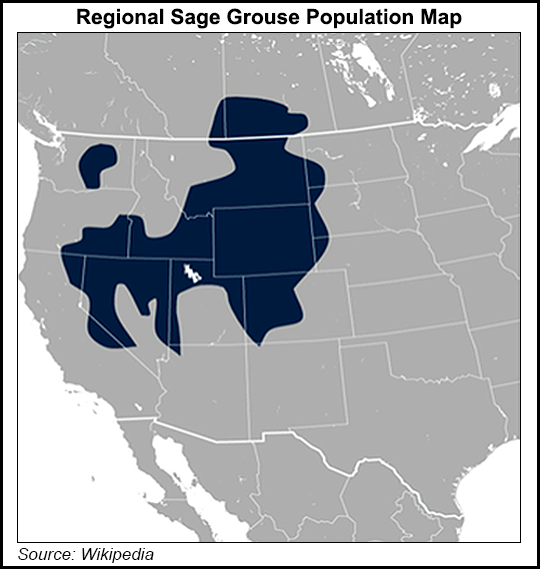Shale Daily | E&P | NGI All News Access | Regulatory
BLM Attempting Once Again to Revamp Sage Grouse Habitat Rules
The Trump administration on Wednesday outlined how it plans to respond to a district court order in Idaho that last year blocked revisions by the Bureau of Land Management (BLM) for greater sage grouse habitat in the West to open more land to energy development.

U.S. District Judge B. Lynn Winmill of the District of Idaho last year blocked the Interior Department agency from modifying the states’ habitat protection plans.
Six draft supplemental environmental impact statements (SEIS) covering the seven states impacted are to be issued on Friday, with public comment accepted until April 6.
BLM considers wildfires and not oil and natural gas development as the biggest threat to the ground dwelling birds, said the agency’s Acting Assistant Secretary Casey Hammond. BLM wants to apply three years of on-the-ground experience to “more closely align” federal requirements with state conservation efforts.
After President Trump took office, BLM began to amend existing habitat protection plans after some of the impacted states “expressed the need to reconcile differences,” Hammond said. States impacted by the updated rules are California, Colorado, Idaho, Nevada, Oregon, Utah and Wyoming.
BLM issued amended plans last March, but conservation groups filed a lawsuit and the district court issued the preliminary injunction. Winmill called out BLM revisions in his ruling, noting that sagebrush focal areas were eliminated in all the plans except for Oregon.
The amended plans initially were developed with bipartisan support, according to Hammond, adopting lessons learned when the plans were approved in 2015 in a milestone decision supported by the energy industry, state leaders and environmentalists.
The original plans adopted five years ago when President Obama was in office remain in effect because of the injunction. Since 2013, an estimated $294 million has been spent on habitat treatment across 2.7 million acres of BLM-managed lands, according to BLM.
“The goal has been to address any issues in the judge’s order and preliminary injunction, and to see if we need to do any additional work or analysis,” Hammond said. “That will be done after the public comment period.”
While BLM’s draft SEIS proposals drew a thumbs up from the Western Energy Alliance, President Kathleen Sgamma said the federal agency still needs to challenge the judge’s ruling. “The judge was insinuating his personal policy preferences into the plans rather than deferring to the wildlife experts at Interior and the legitimate policy direction of the current administration,” she said.
© 2024 Natural Gas Intelligence. All rights reserved.
ISSN © 2577-9877 | ISSN © 2158-8023 |
